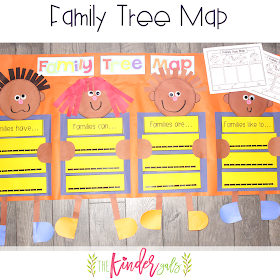Here's a fun way to teach the Life Cycle of the Pumpkin. To make the flow map, I used 12 x 18 construction paper and cut 7 pumpkins. We sequenced the pictures of the life cycle. Then, on each pumpkin we used interactive writing to write each stage.
The kids then made their own pumpkin life cycle accordion fold book.
After reading about the parts of the pumpkin, we made a brace map. The children each made their own paper plate pumpkin to show the parts. (The Pumpkins book is from our November Guided Reading Unit. It is not in the Apples and Pumpkins Unit.) Our unit also has a brace map for the parts of an apple.
What a fun cooking activity for our Fun Fridays. The children made pumpkin pizzas using an English muffin. After baking our pumpkins, we made a pumpkin book to sequence the steps. The children cut apart the scrambled sentences for each step.
On our apples Fun Friday, the kids made pattern apple kabobs using the different colors of apples. We tasted each color to decide which was our favorite. Then we made a "pie" graph to show our data.We also had some fun apples and pumpkin activities in our centers.
At my small group table, we segmented phonemes as we pushed the pumpkin seeds onto the pumpkins in the wagon.
Then, the kids made their own pumpkin cvc books. They selected clip art to glue on their wagons. Then, they stretched the word and wrote the letters to represent the sounds.
This pumpkin seed dice game was a huge hit at my small group table during math. The children roll a dice and put that many seeds on their pumpkin. Then, they roll again. They ask themselves, "What do I need to do with the seeds on my pumpkins so I have the number of seeds as the dots on the dice?" They must decided it they need to take some off (subtract) or put some on (add). The children can record their number sentences on the recording page. (We have this for apples in our unit as well.)
If you already own the Apples and Pumpkins unit, be sure and go to your "my purchases" section on tpt to download the latest version. If you don't have it, you can grab it here.
Want to see more? Check out the product preview.


















































